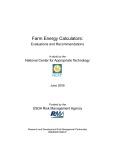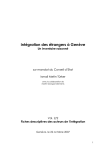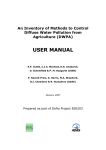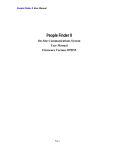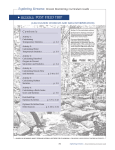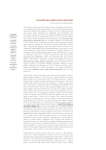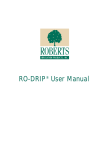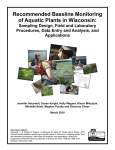Download WCM 19-17 July 12, 2012 - Integrated Pest and Crop Management
Transcript
Volume 19 Number 17 --- University of Wisconsin Crop Manager What’s New Agronomy/Soils Field Day ...........................................57 Two New NPM Apps for Android Smartphones ...........57 Wisconsin Crop Diagnostic Training Center: 2012 Diagnostic Troubleshooting Workshops ........................57 Equipment Emergency Irrigation Considerations – July 2012 .........58 Crops Drought Management Information for Corn Growers .......................................................................59 Getting Additional Forage this Fall ...............................60 Vegetable Crop Update.................................................60 Drought 2012: Forward Contracts and Crop Insurance......................................................................60 Drought and Crop Insurance: Patience Please! ..............61 - - - July 12, 2012 iPhone and iPad, are now available at the Google market for free installation by following the links or scanning the QR codes below. You may also read about the apps on the IPCM website at http://ipcm.wisc.edu/apps/ N Price Calculator Have you ever needed to compare the price of various forms of nitrogen fertilizer products in terms of their price per pound of nitrogen? This app converts the price of each fertilizer product from price per ton to price per pound of nitrogen — allowing for “apples to apples” comparisons. https://play.google.com/store/apps/details?id=ipcm.calc.nprice Corn N Fertilizer Rate Calculator Have you ever needed to know the N rate for corn that will maximize return on investment but didn’t have access to the A2809 “Nutrient application guidelines in field, vegetable, and fruit crops in Wisconsin” book? Weeds Biggest Weed Contest to be held at the Weed Doctor’s Booth at Farm Technology Days in Outagamie County........................................................63 Insects and Mites Corn Rootworm Beetle Emergence and Feeding in Corn Fields ...........................................................................63 Plant Disease Plant Disease Diagnostic Clinic (PDDC).......................63 Agronomy/Soils Field Day The Agronomy/Soils Field Day will be held on August 29 at the Arlington Ag Research Station. Click here or scroll down to the bottom of this newsletter to view the flyer for this event. https://play.google.com/store/apps/details?id=ipcm.calc.nrate Wisconsin Crop Diagnostic Training Center: 2012 Diagnostic Troubleshooting Workshops Dan Heider, UW-Integrated Pest Management Program There is still time to register for the most interactive workshop of the summer. Whether you regularly troubleshoot crop and pest management problems, or if the detective in you simply can’t resist solving a mystery, this is the workshop for you. Because the date is filling fast, I encourage you to use our online registration which is found at https://www.patstore.wisc.edu/ipm/register.asp Diagnostic Troubleshooting Workshop Registration Fee: CCA CEU’s: Location: $75 4.0 (categories to be determined) Arlington Ag Research Station Thursday July 26, 2012 Two New NPM Apps for Android Smartphones Topics covered: The University of Wisconsin Nutrient and Pest Management Program has just released two apps for users of Android smartphones. These apps, which were introduced last year for This workshop gives you the opportunity to fine tune your crop diagnostic skills in a fun, interactive setting! Small groups rotate through field problems with UW Specialists role playing as farmers. Through digging up plants, asking 57 questions and consulting references participants will diagnose the problem and make a recommendation for correction. Each participant will experience 8 separate diagnostic scenarios. For additional information, contact Dan Heider at (608) 262– 6491 or via email at [email protected]. Emergency Irrigation Considerations – July 2012 Scott Sanford (Extension Engineer) With the extended dry weather and no rain in the forecast, growers are looking for alternatives to supply crops with water. Governor Walker has issued a drought emergency declaration for 42 counties in southern Wisconsin which allows growers to pump from state surface waters with a temporary permit from the DNR. (See link to news release in resource list below.) The question is what would it take to irrigate an acre or more of crops? There are four things that are needed to irrigate: water supply, method to transport the water to the field, method to distribute the water to the crops and it has to be economical. Water The water source, quantity and quality are all important. Irrigation water can come from a well, surface source or be food plant or manure effluent. The water quality affects the type of irrigation distribution system that can be used and sometimes the amount of water that can be applied. The limiting factor in most cases for emergency irrigation is the quantity of water required to have a positive outcome. To apply a one inch depth of water to an acre of land requires 27,154 gallons (acre-inch). The water requirement of crops (evapotranspiration – (ET)) in recent weeks has averaged about 0.25 inches per day to grow a productive crop without stress. Therefore, a grower will need sufficient capacity to supply 6,800 gallons of water per day per acre of irrigated land to keep up with plant transpiration and evaporation. If you are pumping from a well or a surface water source and can pump 24 hours per day, this equates to about a 5 gallon per minute flow rate. Growers that have limited water availability often try to water everything a little, but this usually ends with poor results. If the crop doesn’t receive enough water to improve the yield or crop quality, thus resulting in increased income, then the grower is better off doing nothing. Growers should only irrigate the number of acres for which they have an adequate supply of water to meet the plant ET use. If you are irrigating a crop for direct human consumption and using a surface water source, it is recommend that you have the water tested for pathogens and contaminates. The Wisconsin State Lab of Hygiene or other water testing labs can supply that service. Transporting water to the field Water can be pump several miles but may require booster pumps along the pipeline to overcome friction losses and elevation changes. Pumping is the most efficient method for moving large quantities of water. If you don’t have water within pumping distance and are considering trucking water, a semi-tanker can hold 5,500 to 9,000 gallons of water so one tanker load would cover 0.8 to 1.3 acres of area to a water depth of 0.25 inches. Water Distribution system Sprinkler irrigation is typically used to distribute water to row crops. The most practical distribution systems for emergency irrigation are moveable pipe or traveling gun systems. The irrigation system has to match the pump / water supply capacity and pressure. Sprinkler nozzles are sized for a specific design flow rate and pressure in order to achieve uniform distribution of water and therefore must be matched to the proper size pumping system. The sprinkler nozzle must extend above the crop canopy for proper coverage. Moveable pipe irrigation must be set up with the lateral pipe and sprinkle spacing it was designed for to get uniform coverage. Typical spacing is 30, 40 or 60 feet between lateral pipes. A traveling gun systems reduces the amount of labor required and can cover an area of 50 to 300 foot wide and a length of up to 1700 feet depending on the system size, water system pressure and capacity per set. Water system requirements range from 5 to 700 gallons per minute at a pressure of 50 to 70 psi up to 160 psi. The higher the water system pressure, the greater the width of the coverage area. Sprinkle systems are best when using surface water sources or effluent or water with high amounts of dissolved minerals. Drip Irrigation One of the disadvantages of sprinkle irrigation is the amount of water that doesn’t get fully utilized by the crop, either because it is placed too far from the crop’s roots or losses due to evaporation or leaching. Drip irrigation places water at the roots and eliminates much of the evaporation, thus reducing the water volume by 30 to 50%. It also reduces weed control costs because no water is applied between rows and uses low water pressure, usually about 20 psi, resulting in lower energy costs. Drip irrigation requires clean water due to the small openings use to meter the water out and thus filtering is recommended. It is also higher in initial cost. Refer to the Irrigation tool in the USDA Energy SelfAssessment tool at www.ruralenergy.wisc.edu for more information on other types of irrigation systems. Your Wisconsin irrigation equipment dealer can assist with the selection of equipment for your application and aid you with the design and layout of irrigation equipment. Economics This aspect is the hardest for many growers. What is the best option? Should I do anything? Irrigation is expensive to purchase and to operate so it is generally only used on high value crops. The payback on irrigation should be the difference between doing nothing and purchasing and operating irrigation for the “typical” year with 2012 being very a-typical. If you can’t recover the amortized cost of an irrigation system with increased yields or higher quality in the “average” year over a period of years, then it’s a poor investment and one should take the drought loss this year. Resources: 58 Sprinkler Irrigation Systems, MWPS-30, Midwest Plan Service, Ames, IA, http://www.mwps.org/ DNR to expedite farmers’ water diversion requests due to drought emergency, Wisconsin DNR – http://dnr.wi.gov/news/breakingnews_lookup.asp?id=2421 Waterway & Wetland Permits: Withdrawals & Irrigation, Wisconsin DNR http://dnr.wi.gov/waterways/water_levels_crossings/irrigation. html Drip Irrigation on-line references Drip Irrigation Design Guidelines – http://www.irrigationtutorials.com/dripguide.htm Drip Irrigation Planning Guide – http://cdn.dripworks.com/downloads/manuals/DripPlanningGu ide.pdf Ro-Drip User Manual – Roberts Irrigation Products, Inc – http://www.trickl-eez.com/rodrip.pdf Wisconsin Agricultural Irrigation Dealers Roberts Irrigation, Plover, WI – 715-344-4747 – http://www.robertsirrigation.net North Central Irrigation, Beloit – 800-924-0321 and Plainfield, WI – 800-755-0268 http://www.valleynci.com/ Oasis Irrigation, Almond, WI – 715-366-8000 – http://oasisirrigationllc.com/index.htm TIP, Inc, Custer, WI – 800-225-9727 – http://www.tipinc.net/index.html There are also many drip irrigation equipment suppliers online. Drought Management Information for Corn Growers Nitrate Toxicity Issues in Barren Corn: http://wisccorn.blogspot.com/2012/07/nitrate-toxicity-issuesin-barren-corn.html Options for Double Cropping Barren Corn: http://wisccorn.blogspot.com/2012/07/cropping-options-fordouble-cropping.html Corn Transgenic and Trait Technologies in UW Trials during 2012: http://wisccorn.blogspot.com/2012/07/corn-transgenic-andtrait-technologies.html Corn Management Decisions During Drought Depend Upon Pollination Success Joe Lauer I have been dreading writing this article. I was hoping rain might fall, but the forecast is not positive for the next 10 days. It is becoming clear that corn farmers in the southern four tiers of counties in Wisconsin might have to make the best of a bad situation. After pollination (July 10 to August 1), the key plant indicator to observe and base future management decisions upon is the success of pollination. Each ovule (potential kernel) has a silk attached to it. When a pollen grain falls on a silk, it germinates, produces a pollen tube that grows the length of the silk which fertilizes the ovule in 12 to 28 hours. If fertilization of the ovule is successful, within 1 to 3 days the silk will detach from the developing kernel. Silks will remain attached to unfertilized ovules and be receptive to pollen up to 7 days after emergence. Silks eventually turn brown and dry up after pollination is over. Joe Lauer has posted several new articles to his blog containing drought management information. You can find links to each of the articles below. We have reprinted one of the articles following the links. A Tale of Two Extremes: http://wisccorn.blogspot.com/2012/07/tale-of-twoextremes.html What Happens Within the Corn Plant When Drought Occurs?: http://wisccorn.blogspot.com/2012/07/what-happens-withincorn-plant-when.html Corn Management Decisions During Drought Depend Upon Pollination Success: http://wisccorn.blogspot.com/2012/07/corn-managementdecisions-during.html Harvesting Barren and Poorly Pollinated Corn: http://wisccorn.blogspot.com/2012/07/harvesting-barren-andpoorly-pollinated.html Pricing Drought Stressed Corn: http://wisccorn.blogspot.com/2012/07/pricing-droughtstressed-corn.html Two techniques are commonly used to assess pollination success or failure. The most rapid technique to determine pollination success is the “shake test.” Carefully unwrap the ear husk leaves and then gently shake the ear. The silks from fertilized ovules will drop off. The proportion (%) of silks dropping off the ear indicates the proportion of future kernels on an ear. Randomly sample several ears in a field to estimate the success of pollination. The second technique is to wait until 10 days after fertilization of the ovules. The developing ovules (kernels) will appear as watery blisters (the “blister” R2 stage of kernel development). 59 Management Guidelines for Handling Cornfields with Poor Pollination Typical management options and uses are available for corn that has successfully pollinated. If pollination is unsuccessful, we are usually trying to make the best of a bad situation. If pollination is good, harvest in a normal fashion for either grain or forage use. If pollination is poor yet some kernels are developing, the plant can gain dry matter and farmers should wait with harvest. In Wisconsin, many farmers have the option of harvesting poorly pollinated fields for silage use. If there is no pollination, then the best quality forage will be found as close to flowering as possible. Quality decreases after flowering. The challenge is to make sure that no potential pollination occurs and that the forage moisture is correct for the storage structure. Drought-stressed corn can be grazed or used for forage, either as green chop or silage. Because of the potential for nitrate toxicity, grazing or green chopping should be done only when emergency feed is needed. The decision to chop corn for silage should be made when: 1. You are sure pollination and fertilization of kernels will not or did not occur and that whole-plant moisture is in the proper range for the storage structure so that fermentation can occur without seepage or spoilage losses. If there is no grain now, florets on the ear were either not pollinated or have not started to grow due to moisture stress, and the plant will continue to be barren. If the plant is dead, harvest should occur when whole plant moisture is appropriate for preservation and storage. 2. If pollination and fertilization of kernels did occur but it was poor, do not chop until you are sure that there is no further potential to increase grain dry matter and whole plant moisture is in the proper range for the storage structure. These kernels may grow some, if the plant is not dead. If kernels are growing, dry matter is accumulating and yield and quality of the forage is improving. Green, barren stalks will contain 75-90% water. If weather remains hot and dry, moisture content drops, but if rain occurs before plants lose green color, plants can remain green until frost. Drought stressed corn has increased sugar content, higher crude protein, higher crude fiber and more digestible fiber than normal corn silage. Drought generally reduces yield and grain content resulting in increased fiber content, but this is often accompanied by lower lignin production that increases fiber digestibility. Getting Additional Forage this Fall Dan Undersander (Forage Agronomist), Shawn Conley (Soybean and Wheat Extension Specialist) Some farmers need additional forage and want to plant a second crop following wheat or corn taken early for silage due to drought. As of July 15, the best option is to wait until after August 1, and then consider planting oats with or without peas. While corn may yield as well as any other crop, it is more expensive to plant and will need a frost to dry down the forage sufficiently for ensiling. Sorghum-sudangrass, sudangrass and millet require 80 degree or higher temperatures for significant growth. Hot as it may seem now, those temperatures are not likely to occur on a daily basis after Sept 1. So little fall growth will occur and yield will be low. Oats, planted the first week of August can be expected to produce 2.5 to 3 t/a dry matter in an average year. Other small grains will generally produce about half as much since they do not put out a stem. Adding 20 lb/a peas to the oats will increase palatability but will not affect yield. Coblentz, USDA Dairy Forage Research Center, found that a late-maturing forage cultivar (ForagePlus) produced maximum annual yields ranging from 2 to 3.5 t DM/a. Because the forage cultivar matured slowly it was better able to respond to sometimes erratic late-summer precipitation. These types mature later and produce more tonnage of quality forage. If seed of a forage type is not available, plant a late maturing oat variety. After the first week of August use of a forage type oat will provide less advantage and grain-type cultivars often may be better management choices. The fall planted oat is higher in forage quality than spring planted oats. Research at the University of Wisconsin by Albrecht found that maturation of summer-sown (August) oats was delayed, resulting in 10 to 15% less neutral detergent fiber (NDF), 18% greater digestibility, and 250% more water soluble carbohydrate than spring-sown oat. The recommendation would be to plant 1.5 to 2 bu oats/acre (with or without peas). Soil test to determine if sufficient residual nitrogen remains for the oat crop following the drought-reduced corn crop. If not, fertilize with 60 to 70 lb nitrogen per acre at planting. It is also important to check for any herbicide plant back restrictions prior to planting the oat or oat/pea mixture. Planting should occur during the first week of August as earlier planting will result in earlier maturation and reduced yield. Vegetable Crop Update 7/11/12 The 16th issue of the Vegetable Crop Update is now available. This issue contains information on heat impact and drought management. Click here to view this update. Drought 2012: Forward Contracts and Crop Insurance Paul D. Mitchell (Agricultural and Applied Economics, UWMadison/Extension), Brenda Boetel (Agricultural Economics, UW-River Falls/Extension) Many Wisconsin farmers have forward contracts with a local elevator or ethanol plant or have sold futures contracts on the Chicago Mercantile Exchange. With the current drought, many of these farmers are concerned that they may not have the grain to meet these contracts. Most Wisconsin farmers also buy crop insurance – 69% of corn acres and 74% of soybean acres were insured in 2011, with even more acres likely insured in 2012. Many farmers are wondering: What if I do not have the grain to make delivery on contracts and I have crop insurance? Should I do something now? This bulletin is a quick summary of things to consider. 60 Don’t Panic The season is far from over. Timely rains can still mean a substantial crop for many growers. Corn is about to move into the crucial pollination phase and soybeans will continue to flower into August, so well-timed rains could still mean sizeable yields this fall – we just need patience to see how the next month or so develops. Each farmer will have to wait and assess yields once these reproductive phases end for their crops. With this information, farmers can then determine if meeting grain delivery obligations will be a problem. Farmers who think they will have shortfalls and will not be able to meet delivery requirements for forward contracts may want to communicate now to see how they will be asked to meet requirements. Will they have to buy grain on the open market, pay transportation, and make delivery themselves or is there some other way to proceed? This information can help farmers make better plans for the future. Know Your Policy In the meantime, some farmers may want to make marketing adjustments in response to current high prices. A key issue is to know the specifics of your policy: do you have Revenue Protection, Revenue Protection with the Harvest Price Exclusion or Yield Protection? Look over your policy and/or call your insurance agent to clarify if you do not know. In particular, be sure to know if you have Revenue Protection or Revenue Protection with the Harvest Price Exclusion, as these will likely have different price guarantees this fall. Revenue Protection Revenue Protection (RP) is the most popular policy for corn and soybeans in Wisconsin. With RP, the guaranteed revenue increases with the market price. The RP revenue guarantee for corn was calculated using a price of $5.68/bu this spring, but the final guarantee will be calculated using the average during November of the December corn futures contract on the Chicago Mercantile Exchange (CME). For soybeans, guarantees were determined using a price of $12.55/bu this spring, but the final guarantee will be determined using the October average of the November soybean contract on the CME. The main point is that, with RP, a farmer will either have the grain at harvest time (if yield losses are not too large) or the money to buy grain at harvest time prices (if yield losses trigger insurance indemnities) to fulfill contracts with delivery requirements at harvest. Insured farmers that have contacts with later delivery dates and have yield losses can use RP indemnities to buy grain in December and store it until delivery. Yield Protection Yield Protection (YP) is another popular crop insurance policy in Wisconsin. YP only pays indemnities if a farmer’s harvested yield is less than the chosen yield guarantee, regardless of the price at harvest. For farmers with YP, corn yield losses will be paid using a price of $5.68/bu and soybean losses with a price of $12.55/bu, no matter what the price is at harvest. If current market prices continue, farmers with YP who have forward contracts and expect a yield shortfall will likely have to buy grain at higher prices than will be paid by their insurance. These farmers may want to buy futures contracts to offset their price risk, if they think the price at harvest will be higher. This price risk is the same each year for farmers with forward contracts who buy YP. Every year, these farmers bear the risk of having yield losses and having to buy grain at market prices higher than will be paid by their insurance. Farmers concerned about this risk should either buy RP in the spring instead of YP or use existing futures markets to offset their price risk. Revenue Protection with the Harvest Price Exclusion Revenue Protection with the Harvest Price Exclusion (RPHPE) is not a common crop insurance policy in Wisconsin. RP-HPE is the same as RP, except that the revenue guarantee does not increase with the harvest price in the fall. Thus, RPHPE only protects farmers from price decreases, not price increases. Much like YP, if current market prices continue, farmers who have forward contracts and expect a yield shortfall will likely have to buy grain at higher prices than they will be paid by their RP-HPE policy. These farmers may want to buy futures contracts to offset their price risk, if they think they will have a yield shortage for their delivery contracts and they think the price at harvest will be higher. Livestock as a Forward Contract Farmers with livestock essentially have a forward contract with delivery obligations: if they have a yield shortfall, they will have to buy feed for their livestock or sell (part of) the herd. Thus, the same principles explained above apply to these farmers, even if they do not have formal forward contracts. Farmers who do not have RP, if they think prices will be higher than current prices when they will need the grain, should consider buying a forward contract to receive delivery of grain. However, farmers with RP can use indemnities paid in December, calculated at existing market prices, to buy grain and store it for their livestock needs. Final Thoughts The drought will likely have significant price impacts, but farmers with a marketing plan do not need to panic. A good marketing plan allows for flexibility and as in any year, adjustments to the marketing plan should be considered. This year illustrates the need for flexibility and the usefulness of crop insurance for managing marketing risk. For More Information Contact the authors for more detailed questions. Also, see the UW Extension FYI Drought 2012 web page for a wide variety of information on the drought: http://fyi.uwex.edu/drought2012/. Drought and Crop Insurance: Patience Please! Paul D. Mitchell (Agricultural and Applied Economics, UW Madison/Extension) The year began with plentiful moisture and high hopes as Wisconsin planted 4.35 million corn acres and 1.69 million soybean acres, a Wisconsin record for both. The drought and 61 high temperatures in Wisconsin and other states are getting national attention as the weather pattern across the Midwest continues. Timely rains can still allow many acres to produce some yield – patience over the next few weeks will clarify just how Wisconsin crop yields will turn out. Most of these corn and soybean acres are insured in Wisconsin. Acreage reports are not due until July 15th, so data for 2012 are not yet compiled, but in 2011, 69% of corn acres and 74% of soybean acres were insured, with even more acres likely insured in 2012. This bulletin is a quick summary of things to remember for farmers who bought crop insurance for their corn and/or soybeans, as many farmers are concerned that they already have crop losses in 2012 and many farmers are still relatively new to crop insurance. Farmers who insured their corn for silage can receive an indemnity not only if their silage yield is low, but also if their silage is grain deficient. If you believe your silage is grain deficient, contact your crop insurance before you harvest, as a loss adjuster will likely need a representative sample from the standing crop to determine indemnities. Given the wide extent of the drought, loss adjustors will be busy throughout the Midwest. Expect delays in getting permission for alternative crop uses, especially for grazing. It is likely difficult for most growers to leave ungrazed strips for loss adjustors to use later for determining indemnities, so growers will have to wait for an adjustor to visit fields before receiving permission to graze an insured crop. Patience Call Your Agent Insured farmers should communicate with their crop insurance agents during this time of drought. Drought is not a single event, so the 72 hour notice of loss requirement does not apply as for hail and similar losses. However, farmers who think they have yield losses that will trigger payments should call their agents and let them know. Agents will likely start an official notice of loss, which means that eventually an adjustor will come to the farm, but at this time, most growers will likely receive instructions by telephone on how to proceed. You will likely be required to leave a sample of the crop in the field of a specific size for the adjustor to inspect later. A loss adjuster will eventually visit the damaged crop to take samples and may ask for more information such as planting date records and other documents. Work closely with your crop insurance agent to ensure that coverage is not lost due to a technical issue. Things to Remember You cannot graze an insured crop or chop it for forage or silage without first receiving permission from your crop insurance agent, or you will forfeit indemnities. The same applies if you decide to terminate the insured crop and plant a new forage crop – you must first receive permission or you will forfeit any indemnity. Expect to leave representative samples of the insured crop for determining indemnities and if these strips have high enough yields, you will not receive an indemnity. Note that you do not have to use the forage yourself, but can sell it. The adjuster will assess your yields and explain your options. Using drought stressed crops for forage, silage, or grazing can be different than normal crops. To avoid problems such as nitrate toxicity, see some of the assembled resources listed below. Aflatoxin and related issues can also be a problem for drought-stressed grain. Aflatoxin and other grain quality problems are insurable causes of loss, so growers can receive indemnities for problems. If you suspect aflatoxin, mycotoxin, or other grain quality problems, contact your crop insurance agent before you harvest the grain, place it in storage, or deliver it for sale. Loss adjusters will need representative samples from the standing crop to determine indemnities. The final extent of crop losses as a result of the dry weather and heat is far from clear. Timely rains could still allow corn and soybeans to produce sizable crops. Modern corn hybrids are more drought tolerant than in years past and soybean flowering will last into early August, so there it still time for rain to save part of the yield for these crops, we just have to wait and see what happens. Furthermore, crop agents and especially loss adjustors will likely be very busy this year, meaning longer waits before adjustors can visit fields. Insured growers should expect delays, especially if they want to graze an insured crop, so start early if this is your plan – maintain contact with your crop insurance agent to keep moving the process along. For More Information UW Extension FYI Drought 2012: http://fyi.uwex.edu/drought2012/ Dr. Joe Lauer, UWEX Corn Agronomist, Main page http://corn.agronomy.wisc.edu/ and Corn Blog: http://corn.agronomy.wisc.edu/Season/Default.aspx Dr. Shawn Conley, UWEX Soybean and Small Grain Agronomist, Main page http://soybean.uwex.edu/ and Soy Blog http://thesoyreport.blogspot.com/ Dr. Dan Undersander, UWEX Forage Agronomist: http://www.uwex.edu/ces/forage/ UWEX Wisconsin Beef Center: Summer Drought 2012 Resources (Forage Resources) http://fyi.uwex.edu/wbic/2012/07/09/summer-2012-droughtresources/ UWEX Farmer to Farmer Hay, Forage & Corn List: http://farmertofarmer.uwex.edu/index.cfm, or contact your local UWEX county agent. Drought and Alternative Uses of Insured Crops: Can I Chop My Insured Corn for Silage? http://www.aae.wisc.edu/mitchell/Insurance_and_Silage.pdf USDA-RMA Aflatoxin and Crop Insurance Fact Sheet: http://www.rma.usda.gov/fields/mn_rso/2007/2007stpaulaflato xin.pdf 62 Biggest Weed Contest to be held at the Weed Doctor’s Booth at Farm Technology Days in Outagamie County Check cornfields before 70% of the field has silked, and count the number of beetles per plant on 10 random plants from five areas of the field. Record the level of silk clipping (in inches from the tip of the fresh silk to the husk). Mark Renz, UW-Madison Extension Weed Scientist Treatment with a foliar insecticide is warranted when the following conditions occur: The weather has been crazy this spring and summer, but the Weed Doctors are betting that big weeds are still widespread in Wisconsin. Have a weed in your field that you think is a prize winner? Then cut it down and bring it to Farm Technology days and enter it in the contest. All you need to do is bring it in to the Weed Doctors booth in the Progress Pavilion and we will enter you in the competition. We will have daily and an overall winner, and will report the winners at the conclusion of the event. Last year’s winner (common burdock) was 95 inches tall and 95 inches wide and easily beat the more slender competitors. So start scouting those fields now for the winning entry. The only rules of the contest are that 5 or more adults per plant, Pollination has not yet occurred or is less than 50% complete, and Silks are clipped to ½-inch or less Joe Lauer, UW-Madison Corn Agronomist, has posted several new articles containing drought management information for corn growers, including Corn Management Decisions During Drought Depend Upon Pollination Success, which explains how to determine if an ear has been pollinated. weeds can’t be woody plants (e.g. trees) weeds can’t be poisonous plants weeds must be “donated” for display at the Doctors booth. Winners will receive a weed identification book and of course the honor of being able to grow the biggest weed in Wisconsin in 2012. It is important to scout cornfields now for corn rootworm beetles and silk clipping. Conferring with Joe Lauer this morning about corn pollination and drought stress, we agree this is a critical period (July 10 to August 1) to protect silks in the event that rain arrives in time. After pollination, there is no risk or need to treat for corn rootworm beetles. Corn Rootworm Beetle Emergence and Feeding in Corn Fields Hammond, R.B., A. Michel and J.B. Eisley. 2009. Corn Rootworm Management. The Ohio State University, Publication FC-ENT-0016-09 1. 2. 3. Eileen Cullen (Extension Entomologist) Because corn rootworm beetles can reduce yield by silk pruning, it is important to scout cornfields before and during early pollination. This is especially important now under drought conditions also adversely affecting pollination by disrupting the ‘nick’ or synchronization of pollen shed and silk emergence. Corn rootworm beetle emergence is underway and beetles are being reported feeding on corn leaves and silks. Western corn rootworm beetles are more common in Wisconsin, but you will find northern corn rootworm adults as well. When corn rootworm beetles emerge before silking, they feed on the green tissue of the corn leaf surface in fields where they emerged. This results in leaves with green tissue scraped away. Rootworm beetles prefer silks and corn pollen as a food source. Corn growth stage in a particular field in relation to surrounding fields will influence how attractive a field is to corn rootworm beetles. Entomologists talk about a “donor field”, a “receiver field”, or a “neutral field”. These terms relate to the timing of pollination. A field that pollinates later than surrounding cornfields will be attractive to beetles (receiver field) from fields that have finished pollination (donor field). If most fields on a farm or in a local area pollinate around the same time (neutral fields), this lessens the chance of mass movement by beetles into cornfields. References: http://ohioline.osu.edu/ent-fact/pdf/0016.pdf IPM Field Crop Scouting Manual. 2010. Integrated Pest Management Program, University of Wisconsin-Extension Cooperative Extension Service. http://ipcm.wisc.edu/download/pubsPM/IPM-ScoutingManual-2010a.pdf Wright, R.J. and L. Meinke. 1999. Managing Corn Rootworm Adults. University of Nebraska Corn Rootworm Guide http://entomology.unl.edu/pmguides/crwadult.shtml Plant Disease Diagnostic Clinic (PDDC) Brian Hudelson, Ann Joy, Amanda Zimmerman, Adam Greene, Andrew Pape, Plant Disease Diagnostics Clinic The PDDC receives samples of many plant samples from around the state. The following diseases/disorders have been identified at the PDDC from June 29 through July 5, 2012: For additional information on plant diseases and their control, visit the PDDC website at pddc.wisc.edu. 63 AGRONOMY/SOILS F FIELD D DAY ToursandExhibitsofCurrentCropsandSoilsResearch Wednesday,August29,2012 ArlingtonAgriculturalResearchStation ToursdepartfromthePublicEventsFacilityat 8:30am,10:30am,and1:00pm ►Lunchavailablefor$5◄ TourA:Corn/Soybean/Wheat(at8:30and10:30am) RotationandmanagementimpactonFusarium species (DavidMarburger&ShawnConley) TourB:Forages(at8:30and10:30am) BenefitsandcostsofRoundupReadyalfalfa establishmentsystems (MarkRenz) Currentresearchforfindingandmitigating glyphosateresistanceinWisconsincornandsoybean (VinceDavis) ThestatusofnewracesofAphanomycesrootrot alfalfa (DougRouse) Maximizingcornyield (JoeLauer) Managingalfalfaindrought (DanUndersander) Whenarenematodesaproblemforcorn? (AnnMacGuidwin) TourC:Soils(at10:30amand1:00pm) Soilcompaction:Issuesandprevention (FranciscoArriaga) Nitrogenmanagementafteradrought (CarrieLaboski) Covercrops,rootingdepth,andsoilbuilding (MattRuark) Implementingno‐tillthroughtheuseofcovercrops (ErinSilva) LUNCHEONSPEAKER@12:00pm “AnUpdatefromCALS” Dr.KathrynVandenBosch,Dean CollegeofAgriculturalandLifeSciences TheArlingtonResearchStationislocatedonHwy.51,about5milessouthofArlingtonand15miles northofMadison.WatchforFieldDaysigns FormoreinformationcontacttheDept.ofAgronomy608/262‐1390 ortheDept.ofSoilScience608/262‐0485 Intheeventofrain,presentationswillbeheldinside SponsoredbytheUW‐MadisonCollegeofAgriculturalandLifeSciencesandtheUW‐Extension ►CertifiedCropAdvisors:4.5CEUcreditsrequested◄








